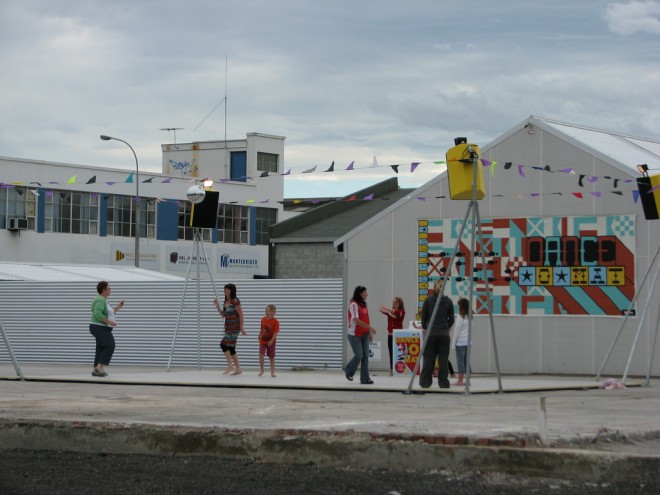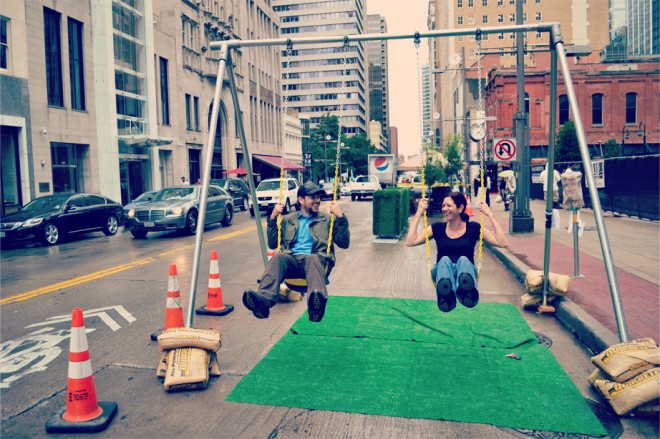A biweekly newsletter with public space news, resources, and opportunities.
A curated dispatch on all things public markets plus the latest announcements from the Market Cities Program.

Robert Linn of the Southwest Detroit Business Association recently turned to the Placemaking Leadership Council’s LinkedIn group for inspiration about how to transform some vacant lots into people-friendly spaces. Members offered up many creative suggestions, while sounding a common theme: the process is as important as the physical improvement. “Passionate communities of interest can bring their resources and talents while gaining benefit from having a presence in the place,” said Arthur Acheson of the Ministerial Advisory Group in Northern Ireland. Anita McKeown, an independent artist and researcher from Ireland, agreed: “Any successful community space must be co-developed by the residents as it will be them who voluntarily manage it and make it successful.”
Chicago Teens Turn a Southside Eyesore into a Playground
Holly Moskerintz of the National Association of Realtors cited a project depicted in her organization’s toolkit. The community-based group Demoiselle 2 Femme, worked with 10 teenage girls to transform a vacant lot in their Roseland neighborhood of Chicago’s south side into a safe place for children. As described in an article in the Chicago Tribune, building the playground provided the young women important lessons about carpentry, project management and community organizing. It even motivated some groups loitering nearby to clean up adjacent public spaces.
A Swing Set, Shipping Container, or Public Dance Floor Can Transform an Empty Space

Simone Sheridan, of The Octapod Association, Australia, marveled at the success of 21 Balançoires (21 Swings) in Montreal, a large swing set where the varying motion of the swings triggers different musical notes. As the project creators describe it, “the result is a giant collective instrument that stimulates ownership of the new space, bringing together people of all ages and backgrounds, and creating a place for playing and hanging out in the middle of the city center.”
The success of 21 Balançoires inspired Dallas-based community designer Patrick McDonnell to use the same concept to create a mobile swing set for temporary application in parking lots, parklets, and other intermittently-occupied places. Swing Park is an innovative Lighter, Quicker, Cheaper-type amenity that he constructed for less than $1000 and has successfully deployed in several areas.

Another structure that has become increasingly popular for vacant lot interventions is a repurposed shipping container. Mr. Acheson suggested one interesting implementation of that approach, Project 24, in Bangor, Northern Ireland, which uses shipping containers as observable artists’ studios, along with an event space and a community garden, all accessible 24 hours a day.
Hunter Franks, an artist from San Francisco, pointed to the innovative approach of Gap Filler, an organization based Christchurch, New Zealand that creates temporary activations of vacant lots with Dance-O-Mat, a coin-operated dance floor that allows anyone to plug in their own music device and start a public dance party or performance. It has been used in three different locations in the city since its debut in 2012.

Ideas and Tools Abound for Using a Vacant Lot to Build Community
There are several fantastic organizations that specifically support vacant lot interventions. PPS’s Philip Winn posted about New York’s 596 Acres, “a great hub and resource for ideas about inventive uses for vacant property, and for actively engaging communities in the process.” The organization provides comprehensive online tools that enable residents to: identify vacant properties and plot them on an interactive city-wide map; link to municipal data sources to find ownership status; learn about government programs and legal options for adopting the management of a space; connect citizens, build community groups and assemble resources to improve the spaces; and advise and support the creation of long-term sustainable management.
The Center for Community Progress is the leading US organization dedicated exclusively to fighting systemic blight and vacant properties. They recently published a report, “Placemaking in Legacy Cities: Opportunities and Good Practices,” about opportunities for adapting Placemaking in different settings, downtowns, anchor districts, neighborhoods and corridors/trails, specifically in the context of cities with the greatest opportunities for these types of transformations—the “former industrial hubs that experienced industrial and population declines during the latter half of the twentieth century.”
The Lighter, Quicker, Cheaper approach is a valuable tool when starting work on a vacant lot (or enriching any destination, for that matter). It is an incremental approach that uses low-cost experiments and the local resources and talent available. LQC allows you to test out various concepts in a space to create an impact quickly, then find out what works and what doesn’t before making any more permanent, costlier changes.

The First in a New Blog Series Featuring PLC Member Discussions
Since launching the Placemaking Leadership Council last April, the Council’s online home—a private LinkedIn group—has proven to be a lively forum for continuing discussion of Placemaking topics from around the world. In order to share with those outside the Council, we are initiating a new blog series featuring content from those discussions.
This conversation about vacant lots is just a small sample of the activity taking place within the LinkedIn group. If you are already a member of the PLC but have not yet joined the LinkedIn group, we encourage you to do so. If you are not a PLC member yet are involved in the Placemaking movement, we encourage you to check out the Council and consider applying. For everyone else, we will continue to report from time to time on the fantastic ideas and resources that PLC members are sharing.
The rich text element allows you to create and format headings, paragraphs, blockquotes, images, and video all in one place instead of having to add and format them individually. Just double-click and easily create content.
The rich text element allows you to create and format headings, paragraphs, blockquotes, images, and video all in one place instead of having to add and format them individually. Just double-click and easily create content.
Body Text Body Link
The rich text element allows you to create and format headings, paragraphs, blockquotes, images, and video all in one place instead of having to add and format them individually. Just double-click and easily create content.
Here is some highlighted text from the article.




Headings, paragraphs, blockquotes, figures, images, and figure captions can all be styled after a class is added to the rich text element using the "When inside of" nested selector system.
Headings, paragraphs, blockquotes, figures, images, and figure captions can all be styled after a class is added to the rich text element using the "When inside of" nested selector system.
Headings, paragraphs, blockquotes, figures, images, and figure captions can all be styled after a class is added to the rich text element using the "When inside of" nested selector system.